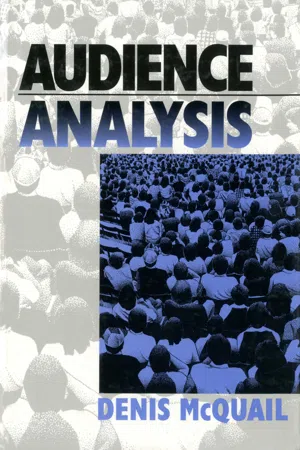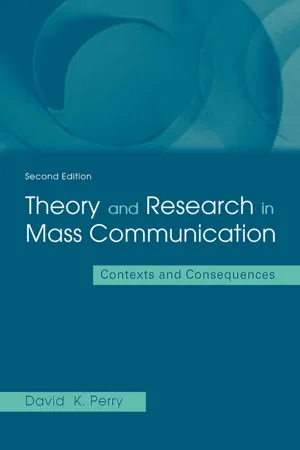Social Sciences
Media Audiences
Media audiences refer to the individuals or groups who consume media content, such as television, radio, or online platforms. Understanding media audiences involves analyzing their demographics, behaviors, and preferences to tailor content and advertising. This field explores how audiences interpret and engage with media messages, as well as the impact of media on their attitudes and behaviors.
Written by Perlego with AI-assistance
Related key terms
8 Key excerpts on "Media Audiences"
- eBook - ePub
- Denis McQuail(Author)
- 1997(Publication Date)
- SAGE Publications, Inc(Publisher)
SIX
AU diENCE PRACT iCES : SOC iA l USES OF THE ME diA
Media Use and Everyday Life
The approaches described in the two previous chapters have problematized the “audience” as an uncertain outcome of many individual acts of more or less motivated choice. These acts can, up to a point, be accounted for by a number of interacting causal factors—the pushes of individual needs and social pressures, the disposition of circumstances, the relative attraction of particular media offerings. This way of formulating the problem stems from the motives that have guided most audience research: meeting the needs of media industries or the aims of media propagandists and responding to public concerns about harmful media effects.From each of these perspectives, media use tends to be viewed as a causally motivated sequence of behavior, which is open to both prediction and modification in some relevant way. In the same vein, Webster and Phalen (1994) pointed to three main audience models in communication policy that position the audience respectively as: “victim” (in the effect model); “consumer” (in the marketplace model); and “coin of exchange” (in the commodity model). Whatever the model, the audience in these conceptualizations is more a statistical abstraction than a human constellation.More recently, an audience research school has developed that has tried to avoid and even counter this way of looking at audiences by treating media use as an integral part of something more fundamental, namely the patterns of everyday social interaction and experience that not only influence specific media behaviors but that also govern the meaning that media use has for its audiences (Moores, 1993; Silverstone, 1994). The general term reception research - eBook - ePub
- David Morgan(Author)
- 2008(Publication Date)
- Routledge(Publisher)
2 AudiencesStewart M. Hoover
Media change and religious change Religious authority and media authority The religious “marketplace” “Religious” and “secular” media The culturalist turn in media studies Audiences in context Religion, spirituality, and the “common culture”
Audiences are essential to the media. The entire notion of mass communication depends on the existence, or cultivation, of a large number of people interested in attending to a given medium. There is, further, a relationship between generally accepted conceptions of the various media and the audiences that are attracted to them. For example, newspapers such as the New York Times or the Washington Post enjoy the devoted readership of the intelligentsia and managerial elites, whereas Web logs (or “blogs”) command far greater attention among youth. Thus, media influence varies according to audience.Our received ideas about mass communication, and thus Media Audiences, are the products of particular times and particular media structures. The term mass communication best describes a few particular media and particular conditions of audience practice. It applies to broadcast television over large networks particularly well but also fits large-circulation newspapers, film, and the popular music industry. “Mass communication” does not work so well with other aggregations of Media Audiences that nonetheless share commonalities with these examples, such as music performance venues, specialized videos or DVDs, limited-circulation newspapers and magazines, and print literature.A process of rethinking mass communication and Media Audiences has been underway for at least three decades. This rethinking has coincided with—and to some extent has also been encouraged by—the reconceptualizing of a particular mode of audience practice: the consumption of mediated communication in relation to religion and spirituality. Seeing audiences anew has involved a shift in the way in which media scholars and critics characterize those audiences. Instead of regarding “religious audiences,” whose identities and motivations toward religious or spiritual material would be assumed to reside in an essential, definitive religiosity, it has become important to think of the audience for religion - eBook - ePub
Media Audiences
Is Anybody Watching?
- Sue Turnbull(Author)
- 2020(Publication Date)
- Bloomsbury Academic(Publisher)
2 What is a Media Audience?Let’s start with a question. What do you think of when you hear the term ‘media audience’? What image pops into your mind? Is it the stock photo of a nuclear family sitting round a television set watching a programme in their living room (see Illustration 2.1 )?Is it people watching a film at the cinema (see Illustration 2.2 )?Is it people reading a newspaper on a train (see Illustration 2.3 )?All of these activities, and many more, have been identified as media audience practices in relation to what is now described as ‘legacy’ media. This would include the printed newspaper or magazine, listening to the radio or watching television, and a trip to the local cinema. The major difference being that we can now access all of that content on a hand-held device, anywhere and anytime, providing we have the funds to acquire the right technology and a reliable internet connection. As Adam Greenfield has observed in his book Radical Technologies: The Design of Everyday Life (2017), smartphones have indeed ‘altered the texture’ of people’s lives all over the world in extraordinary ways, transforming everyday rituals as well as people’s relationship to the spaces which they inhabit: spaces in which they can now be part of a media audience anywhere and anytime.Reliable internet connectivity, however, is by no means a given in many parts of the world, leading to what has been described as a ‘digital divide’ that separates more affluent communities from those who are less privileged. The speed with which audiences can access content can also varies considerably. In 2018, it was estimated that while Singapore had the fastest broadband speed in the world at 60.39 megabits per second, the United States came in at number 20 at 25.86 megabits per second, while Australia, where I live, on the other hand, did not even make it into the top 50.1 - eBook - ePub
Media and Society
Power, Platforms, and Participation
- Nicholas Carah(Author)
- 2021(Publication Date)
- SAGE Publications Ltd(Publisher)
As media organizations grew and became more institutionalized and commercialized, they developed methods to quantify, describe and position their audiences for advertisers. Audience and market research techniques and industries developed in collaboration with media organizations. Ratings provided ways of creating the audience as a reliable and quantifiable product that could be sold to advertisers. The size, location and demographic characteristics of the audience are quantified for advertisers who need to know how many of certain types of people’s attention they are buying when they purchase advertising time and space. Qualitative and cultural information about audiences is also important (Hackley 2002; Holt 2002). Media organizations and advertisers seek to qualify the lifestyles, cultural interests, values and practices of their audiences. This informs the production of both media content and advertising. Producers develop ways of understanding how audiences consume media content as part of their everyday lives. They want to understand how media, such as television, are incorporated into the rhythms of everyday life. The development of breakfast television, for instance, responds to the morning routines of middle-class families. Breakfast programmes are light, conversational and repetitive. They are attuned to an audience that has the television on in the background as they get ready for work and school. While the primary driver in the creation of audiences is often their commercial value, these processes are also entwined with broader political and social processes. Advertising is a central part of the broader representational and social role of the media. Just like news, films, books and television programmes, advertising plays a role in creating public identities and social formations (Turow 1997: 26). The work of producing audiences as valuable social formations overlaps with the work of creating publics that sustain particular political formations and configurations of power (Livingstone 2005, 2019).Media organizations invested in the development of these technologies throughout the twentieth century. Television, for instance, relied on a combination of in-home meters, diaries and surveys (Balnaves et al. 2011: 100). Each technology has limitations. Meters monitor what programme is watched whenever the television is on. These provide an accurate count of what is being watched, but they do not enable researchers to specify who in the family is watching. Some research firms added push-button meters that required the members of a family watching to press the button when they were watching. This provided some measure of who was watching. But people wouldn’t push the button if they didn’t want to disclose what they were watching. Diaries provide more detail on who watches what, but they are hampered by getting participants to accurately complete them. People routinely underestimate how much time they spend consuming media. Surveys are hampered both by people’s recall of what they watched, and their willingness to admit to watching certain kinds of content (Balnaves et al. 2011). - eBook - ePub
- Eoin Devereux(Author)
- 2013(Publication Date)
- SAGE Publications Ltd(Publisher)
B efore you read in more detail about how audiences, and the concept of reception in particular, have been understood by media theorists and empirical researchers, reflect for a while on your own experiences as an audience member. Compile a list of the variety of situations in any one day in which you may be a member of a media audience and consider the following issues:1.How many Media Audiences do you actually belong to?2.What sorts of media genres are you predominantly interested in?3.In what social situations are you mainly an audience member?4.Do these social contexts have a bearing on how you interpret the multiplicity of media messages that you encounter?5.How active or reflexive are you as an audience member?6.Where might you see agency or reflexivity in your everyday media experience?7.Which paradigms (effects, uses and gratifications, reception, produser/prosumer) best fit with your personal experiences of being an audience member?Themes and tensions: competing theoretical and methodological approaches in audience researchAs was discussed in Chapter 2 , early behaviourist media research (effects and uses and gratifications) was quite problematic in the ways in which audiences were conceptualized. Within this body of research audiences were understood as either responding slavishly to media messages or simply using and responding to media messages in order to gratify their needs. There was little or no focus on the complexities of media content or how it might be variously understood by different audiences in different social contexts. With this in mind, this chapter takes that most important juncture in the overall development of media and audience research – reception analysis – as its key starting point and considers reception analysis and the subsequent paradigms of audience research in more detail.The methodological fractures and factions evident within the larger project of media analysis – and within the social sciences more generally – come into clearer focus when we examine how empirical research is undertaken on Media Audiences. Two competing methodological paradigms – the quantitative and the qualitative – have traditionally been used within audience-based research. Despite the calls in recent times by some researchers for a more integrated methodological approach, the marked ‘stand-off’ between the quantitative and qualitative camps remains (Schroder, 1999). Crucial epistemological, theoretical and methodological differences exist between these two contrasting approaches (see Figures 8.1 and 8.2 - eBook - ePub
Theory and Research in Mass Communication
Contexts and Consequences
- David K. Perry(Author)
- 2001(Publication Date)
- Routledge(Publisher)
4 Theories of Media AudiencesWhy do you sometimes go to a movie, listen to the radio, turn on the TV set, read a newspaper or magazine, or perhaps surf the Internet? You may be seeking, consciously or not, something that will take your mind off of your worries, help pass the time of day, or predict tomorrow’s weather. In fact, audiences report various motivations for media use. These sometimes include such things as passing time and learning about things or oneself, as well as for arousal, relaxation, companionship, and because of habit (Greenberg, 1974).Clearly, communication is more than a process by which one party, the sender, does something to another, the receiver. The media do not merely act, and those exposed to them do not merely react. Rather, like with other things in life, it takes “two to tango.”USES AND GRATIFICATIONS RESEARCH
The uses and gratifications approach to mass communication research (e.g., Rosengren, Wenner, & Palmgreen, 1985) examines what people do with the media. Sometimes this issue is studied separately from and less often alongside of the question of what the media do to people. Such research assumes that audiences are to varying degrees active participants in media use, rather than purely passive or reactive objects. As E. Katz, Blumler, and Gurevitch (1974) defined the approach, it is concerned with:Contemporary uses and gratifications research tends to reflect five assumptions, according to Rubin (1993):(1) the social and psychological origins of (2) needs, which generate (3) expectations of (4) the mass media or other sources which lead to (5) differential patterns of media exposure (or engagement in other activities), resulting in (6) need gratifications and (7) other consequences, perhaps mostly unintended ones. (p. 20)(a) Communication behavior such as media use is typically goal-directed or motivated. Such behavior is functional for people; it has consequences for people and societies. - eBook - ePub
- James A. Anderson(Author)
- 2012(Publication Date)
- Routledge(Publisher)
1985 ). Biocca correctly observes that the psychological role of the formal features of media is an important area for future study.Finally, Biocca points to the need to “define the role of media socialization and habituation” (p. 73) into the discussion about the audience’s interaction with media. This work could be done at several different levels of analysis, which would include (1) investigation of the development of children’s perception, understanding and use of media; (2) concern for media socialization among particular groups within the audience to address their motives for watching and also the way in which various personality characteristics have a bearing on media use; and (3) study of media socialization within and among cultures and significant subcultures over long time spans.All these recommendations for areas of future investigation by mass communications researchers are worthy of consideration. However, they do cover a broad spectrum, and we are left with a plethora of possibilities. A more systematic taxonomy of types of activity is needed. Furthermore, it might be most useful to develop this classification within a single conceptual reference frame. Since we are concerned principally with aspects of audience “psychological” activity—cognitive, affective, and behavioral processes—a psychological or social-psychological perspective could prove most appropriate.The Audience and Lindlof
Practically all of us who watch television also belong to various social, occupational/professional, or public groups. We may live in a family household or one that we share with friends. Even if we live alone, we may nevertheless regularly come into contact with a variety of other “communities” in which we regularly interact with others. This may be at a place of work, through organized group activities outside work, and through social gatherings with friends and acquaintances. - eBook - ePub
- Peter Sorlin(Author)
- 2013(Publication Date)
- Routledge(Publisher)
The system called Computerized Continuous Preference Indication is said to check the behaviour of all the members of a panel and even to test the depth of their participation. Firms have collected a vast amount of data that social scientists might use to evaluate the comportment, inclinations and options of readers or viewers. 'Meaning', that is to say the content of papers or broadcast programmes, is not necessarily involved in this process; we shall try, later, to work out why messages emitted by the media make sense for those who get them, but what we would like to examine, first, is another, much simpler thing: media sell goods (their messages) that people buy directly (a paper, a seat in a cinema) or indirectly (a broadcast programme): how is it possible to account for the various attitudes of the consumers? Journalists are often criticized for delivering false or exaggerated news but we must not forget that they work under the pressure of a permanent demand; the desire for media is relatively stable, it cannot be simply equated with a hunt for information or entertainment. Statistical surveys seem to provide us with exceptionally good material, but we have to verify whether it fits in with our research. 4 And if it does not, even partially, we must find out how audiences can be best described. The Media and 'Their' Public From people to public Media are directed towards an anonymous entity, the public. David Chaney considers the notion of 'public' to be an example of a fiction, 5 which does not mean that it is a pure fantasy but that it is mostly characterized by its narrative construction
Learn about this page
Index pages curate the most relevant extracts from our library of academic textbooks. They’ve been created using an in-house natural language model (NLM), each adding context and meaning to key research topics.







